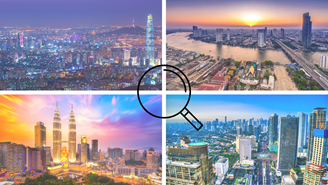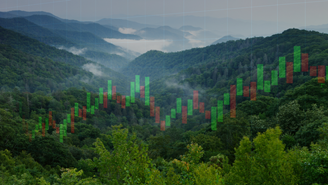Is it time for ocean carriers to chart a new course in the face of global supply chain issues?
Maritime shipping is the most common mode of transport for global trade, with around 80-90% of the volume of international trade in goods carried by sea. Complex supply chain challenges around the world made 2021 an exceptionally challenging year for retailers, exacerbating global inflation. Still, it was also very profitable for ocean carriers and containership owners. In 2022, maritime freight rates will continue to be a significant factor in the supply chain crisis. In the first half of 2022, some markets saw a temporary decline in shipping rates; however, the war in Ukraine and lockdowns in Shanghai, China, have only added to the systemic challenges of the global supply chain disruptions.
Congestion and ship-queueing at ports bring about logistical challenges
In 2020, COVID-19 pandemic-related lockdowns and closed national borders posed challenges for regular, pre-pandemic level sea-trade flows. In the year's second half, the opposite scenario emerged with a major surge in demand on the main routes, a shortage of containers and an increase in freight rates.
In 2021, after the seasonal shopping boom during Lunar New Year in February, there were signs that freight rates had stabilized, and carriers began to resume their regular schedules. However, on 23 March 2021, one of Evergreen's largest operated container ships, the Ever Given, ran aground in the middle of the Suez Canal, blocking two-way traffic for six days. The incident stopped around 300 ships from carrying more than USD 10 billion worth of cargo.1 By June 2021, hundreds of container ships were stranded at entries to ports worldwide due to the pandemic-induced supply chain disruptions, particularly in southern China. Subsequently, severe congestion spilled over at the US ports of Los Angeles and Long Beach, which account for about 40% of sea freight entering the US.2 Although the US reported some improvements in service times for container ships after President Biden called on ports and logistics companies to work around the clock, the president's plan failed to address other challenges, such as the limited availability of equipment and storage capacity that are continuing to cause congestion.
Several uncontrollable external factors have been causing transportation disruptions, such as pandemic-related restrictions and lockdowns, recent shortages of truck drivers and the war in Ukraine. Nonetheless, it has become apparent that ocean carriers’ poor risk assessment and failure to adapt effectively to post-2020 conditions have also aggravated supply chain issues.
Bigger ships beget bigger service problems
A year after the Suez Canal blockage, in March 2022, another megaship managed by Evergreen, Ever Forward, ran aground in Chesapeake Bay in the US. After spending several weeks stuck in the bay and several unsuccessful attempts to free the ship, officials decided to remove containers to lighten its load. The average size of a container ship has doubled in the past 20 years, with the largest ships now capable of hauling 24,000 containers.3 Earlier, in February 2022, the megaship MV Mumbai Maersk spent two days grounded in the North Sea near Germany. Shipping companies claim that larger container ships provide them economies of scale and are more fuel efficient and environmentally friendly. However, megaship companies can drive slower and less reliable commerce. Delays were already significant well before the Ever Given incident in the Suez Canal. For example, there have been decreases in service quality due to more prolonged loading and discharging times; wider ships lead to shoreside cranes requiring more time to unload each container from the vessel. Moreover, stacking containers higher also makes them less stable in strong winds.
Additionally, megaships are more exposed to port navigation problems and fires, which can lead to complex and disproportionately expensive rescue processes in the event of accidents. Finally, port infrastructure has not kept pace with ship sizes - in most cases, port sizes have remained the same in the last few years. The COVID-19 pandemic has also exposed the problem of port constraints and terminal inefficiencies and highlighted a desperate need for ports to invest in newer infrastructure.
Quality and service reliability is down while prices are up
The quality of service from shippers has continuously decreased between 2020 and 2022, while backlogs and delays have worsened, and shippers have shown few signs of adapting to the pandemic. However, shipping freight rates have risen steadily. The increase in containerized trade demand caused by the e-commerce boom has faced capacity constraints in supply. This has led to record-high container freight rates on almost all trade routes. According to Freightos Baltic's index, in 2021, the average price of shipping a container from Asia to the US west coast grew by 500% year on year, amounting to almost USD 20,000 for a 40-foot container, compared to less than USD 2,000 in 2020.4,5
Additionally, cargo owners have faced surcharges and other costs. They state that detention and demurrage (D&D) fees* are unfair when delays are out of their control. They claim they often cannot pick up their containers because of the backlog waiting at port terminals or the shortage of trailers needed to pull containers.
In response to the incredibly high freight rates in the US and retailers' complaints that these rates have risen uncontrollably and are a result of the increased consolidation of the industry, the Ocean Shipping Reform Act 2022 has passed into law in July 2022.6 The act aims to update regulations for the shipping industry and give the Federal Maritime Commission (FMC) greater authority to regulate harmful practices by carriers. Such courses include refusing export cargoes from the US, which became more common starting in 2020 and entails maximizing the number of trips by returning empty containers from the US to Asia to profit from the high prices for Asian exports.7 The new law may expose carriers shipping to the US to increased compliance risks, requiring them to meet minimum service standards to avoid legal actions related to soaring D&D fees. *
Get in touch with Sustainalytics’ Client Advisory team for ESG solutions to help investors better assess industry-specific risks related to supply chain disruptions.
* Detention and demurrage (D&D) fees - demurrage refers to the charge that the merchant pays for the use of the container within the terminal beyond the free time period. Detention refers to the charge that the merchant pays for the use of the container outside of the terminal or depot, beyond the free time period.
Sources:
[1] Bloomberg (March 2021), “How a Desert Wind Blew $10 Billion of Global Trade Off Course”: https://www.bloomberg.com/news/articles/2021-03-27/how-a-desert-wind-in-suez-canal-blew-global-trade-off-course
[2] CNBC (November 2021), “California docks see ‘significant progress’ with supply chain backlog”: https://www.cnbc.com/2021/11/24/california-docks-see-significant-progress-with-supply-chain-backlog-port-chief-says.html#:~:text=Cordero%20said%20that%20the%20twin,the%20clock%20to%20offload%20containers.
[3] The New York Times (March 2021), “Why the World’s Container Ships Grew So Big”: https://www.nytimes.com/2021/03/30/business/economy/container-ships-suez-canal.html
[4] Business Insider (September 2021), “Executives warn customers to brace for continued shortages and price hikes in 2022”: https://www.businessinsider.com/executives-say-brace-for-shipping-delays-price-hikes-next-year-2021-9
[5] Bloomberg (January 2022), “Shipping Companies Had a $150 Billion Year. Economists Warn They’re Also Stoking Inflation”: https://www.bloomberg.com/news/features/2022-01-18/supply-chain-crisis-helped-shipping-companies-reap-150-billion-in-2021
[6] The White House official website (June 2022), https://www.whitehouse.gov/briefing-room/legislation/2022/06/16/bill-signed-s-3580/
[7] Wall Street Journal (June 2022), “Biden Blasts Ocean Carriers as Congress Readies Tougher Shipping Regulations”: https://www.wsj.com/articles/congress-to-toughen-shipping-regulation-as-biden-companies-cite-economic-pain-11654893760




